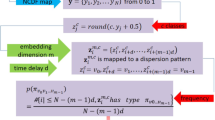Abstract
For many continuous bio-medical signals with both strong nonlinearity and non-stationarity, two criterions were proposed for their complexity estimation: (1) Only a short data set is enough for robust estimation; (2) No over-coarse graining preprocessing, such as transferring the original signal into a binary time series, is needed.C 0 complexity measure proposed by us previously is one of such measures. However, it lacks the solid mathematical foundation and thus its use is limited. A modified version of this measure is proposed, and some important properties are proved rigorously. According to these properties, this measure can be considered as an index of randomness of time series in some senses, and thus also a quantitative index of complexity under the meaning of randomness finding complexity. Compared with other similar measures, this measure seems more suitable for estimating a large quantity of complexity measures for a given task, such as studying the dynamic variation of such measures in sliding windows of a long process, owing to its fast speed for estimation.
Similar content being viewed by others
References
Wu Xiangbao, Xu Jinghua. Complexity and brain function[J].Acta Biophysica Sinica, 1991,7(1):103–106.
Meng Xin, Shen Enhua, Chen Fang,et al., On coarse graining in the complexity analysis of EEG signals I: Over-coarse graining and a comparison among three complexity measures [J].Acta Biophysica Sinica, 2000,16(4):701–706.
Chen F, Xu J, Gu F,et al. Dynamic process of information transmission complexity in human brain[J].Biological Cybernetics, 2000,83(4):355–366.
Yang Sihuan, Yang Qinfei, Shi Jiming,et al. The comparison among complexities of EEG time series in different physiological states using three kinds of algorithms[J].Acta Biophysica Sinica, 1996,12(3):437–440.
Rapp P E, Schmah T I. Dynamical analysis in clinical practice[A]. In: Lehnertz K, Arnhold J, Grassberger P,et al (eds).Chaos in Brains[C]. World Scientific, Singapore, 2000,52–62.
Lempel A, Ziv J. On complexity of finite sequences[J].IEEE Transactions on Information Theory, 1976,IT22(2):75–81.
Pincus S M. Approximate entropy as a measure of system complexity[J].Proceedings of the National Academy of Sciences of the United States of America, 1991,88(6):2297–2301.
Gu F, Shen E, Meng X,et al. High order complexity of time series[J].The International Journal of Bifurcation and Chaos, 2004,14(8):2979–2990.
Lehnertz K, Elger C E. Can epileptic seizures be prediced? Evidence from nonlinear time series analysis of brain electrical activity[J].Physical Review Letters, 1998,80(22):5019–5022.
Author information
Authors and Affiliations
Corresponding author
Additional information
Communicated by Dai Shi-qiang
Project supported by the National Natural Science Foundation of China (Nos 70271065 and 10201008)
Rights and permissions
About this article
Cite this article
En-hua, S., Zhi-jie, C. & Fan-ji, G. Mathematical foundation of a new complexity measure. Appl Math Mech 26, 1188–1196 (2005). https://doi.org/10.1007/BF02507729
Received:
Revised:
Issue Date:
DOI: https://doi.org/10.1007/BF02507729



